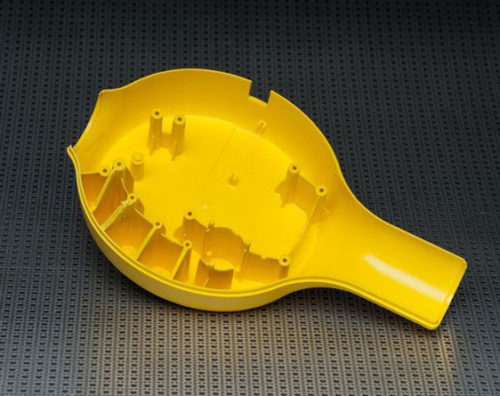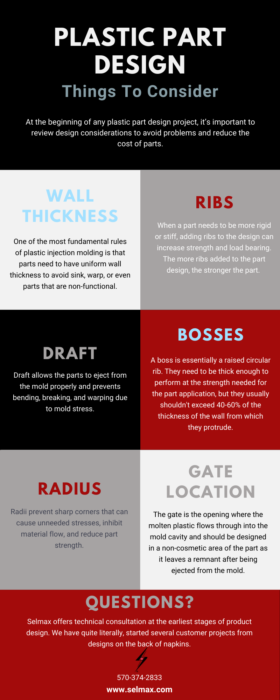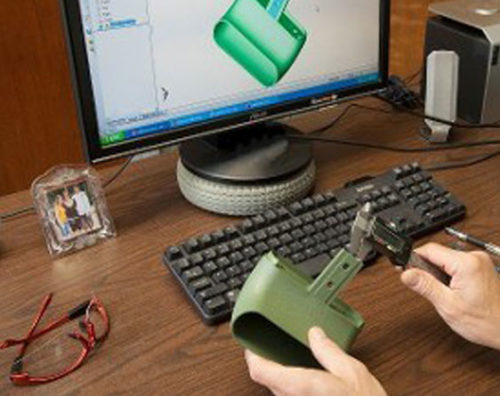Plastic Part Design: 6 Considerations
Leave a CommentPlastic part design for injection molding requires several considerations to ensure that the part is moldable while reducing the risk of costly mistakes.
Part of the appeal of plastic injection molding is the ability to produce thousands to millions of uniform, high quality parts at low cost so you can optimize project profit margins. At the beginning of any plastic part design project, it’s important to review all design considerations to avoid problems and reduce the cost of parts. Even the smallest mistakes can affect tooling costs, increase part costs, and cause problems with molding performance.
Moldability guidelines for plastic parts recommend looking at the big picture of the plastic part design. It’s important to consider everything from materials that will be used to size to surface finishes to custom color matching needs.
6 important considerations when designing plastic parts
1. Wall thickness
One of the most fundamental rules of plastic injection molding is that parts need to have uniform wall thickness to avoid sink, warp, or even parts that are non-functional. Designing proper wall thickness into the part will reduce the risk of cosmetic defects in the finished part. Walls should be within the recommended thickness ranges for the material that will be used. Walls that are too thick are susceptible to sink. If extra strength is needed, supporting ribs should be added instead.
2. Ribs
When a part needs to be more rigid or stiff, adding ribs into the design can increase strength and load bearing capabilities. It’s important to keep in mind that rib thickness should be less than the wall thickness, typically 40% to 60% of the adjacent wall. If a thick rib is needed, the center of the rib should be cored to allow for uniform wall thickness.
3. Draft
Applying draft to the faces of the plastic part is essential for ensuring the part is moldable. Technically speaking, draft is the angle in which the part is tapered to allow it to release from the mold. Draft is designed into every plastic injection molded part in the direction of mold movement. It allows the parts to eject from the mold properly and prevents bending, breaking, and warping due to mold stress.
4. Bosses
A boss is a raised circular rib that is typically designed into the part to help with assembly, as a receptacle for a screw or a pin from another part. While bosses need to be thick enough to perform at the strength needed, they usually shouldn’t exceed 40-60% of the thickness of the wall from which they protrude. If your part requires more strength than that would provide, it’s better to surround the boss with gussets to strengthen its walls.
If the boss is placed close to a vertical wall, it should be anchored with one or two ribs to prevent unnecessary thickness that can result in sink. It’s also important to design draft into each boss to facilitate ejection. Sometimes, shorts or burns may form on the rim of the boss if vent pins aren’t added to allow for trapped gasses to escape during the mold filling process.
5. Radius
Sharp corners don’t typically mesh well with plastic injection molding. A radius can prevent a sharp corner that would otherwise cause unneeded stresses, inhibit material flow, and reduce part strength. Radii should be designed with material selection and end part use in mind.
6. Gate location
The gate is the opening where the molten plastic flows through into the mold cavity. This area can leave behind a remnant that may need to be trimmed by hand after it ejects from the mold. Depending on the style of gate, the plastic used, and the part geometry, the gate should usually be designed into a non-cosmetic area of the part. It is critical to consider gate location in the design phase because it can ultimately make or break the project. Choosing the right type of gate and location can also affect many other areas of the project.

Other Considerations for Plastic Part Design
It’s always best to work with a seasoned injection molder when designing your plastic parts, especially when they are complex or need to pass specific performance tests.
Some common questions a design engineer will ask:
- How will the part be used? Is it a single product or a component of a bigger assembly?
- What are the dimensional and tensile requirements?
- Does the part need to withstand certain elements, pressure, or chemicals?
Spending time and effort on designing the perfect part now can save substantial time and money over the long term.
________________________________________________________________________________________
Selmax offers technical consultation at the earliest stages of product design. We have quite literally started several customer projects from designs scribbled on napkins.
We work closely with our customers to define the requirements of the finished product – physical dimensions, structural supports, custom engraving, color, texture and finishing.
Since 1971, we’ve been providing our customers turnkey solutions from design to delivery. Ready to discover the low-stress experience of working with a full-service manufacturer?
REQUEST A QUOTE
Save this graphic for future reference










